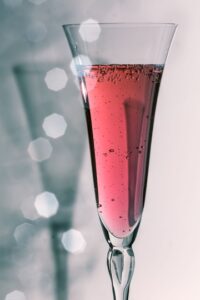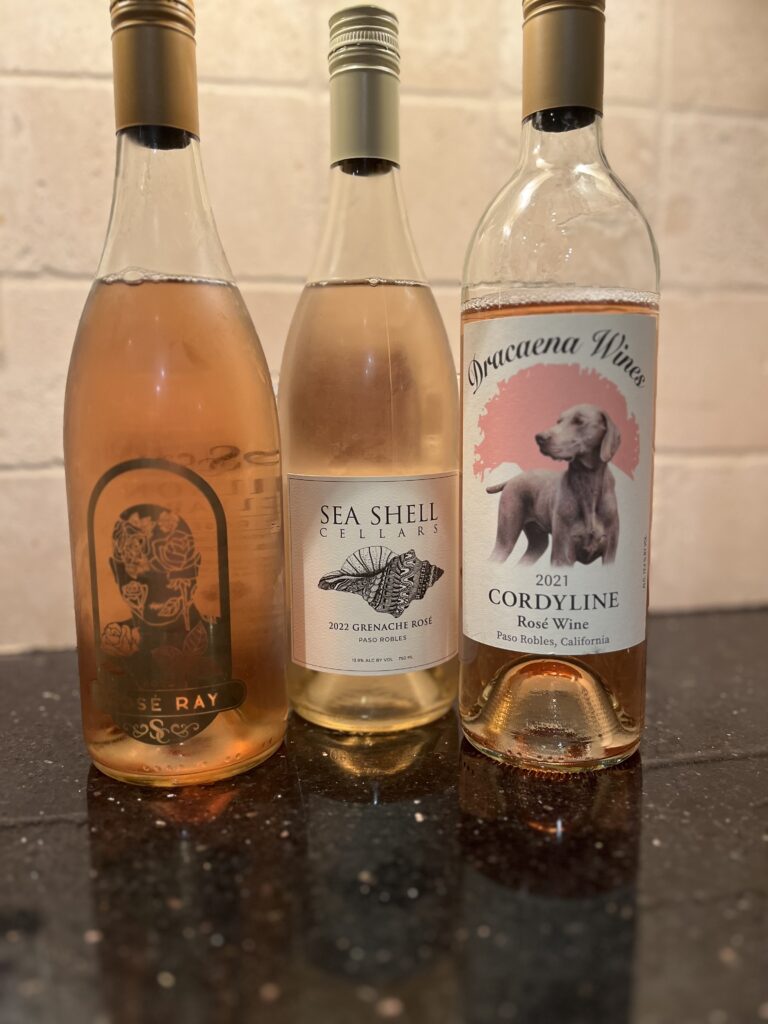 Happy Valentine’s Day everyone! (a week late) The day of romance is linked to some not so romantic stories. But what is romantic is cozying up with your loved one with a wonderful glass of wine. And it is hard to find a wine that screams out romance more than rosé. So with Valentine’s Day in the rearview mirror, I thought I’d share a bit of wine and romance history.
Happy Valentine’s Day everyone! (a week late) The day of romance is linked to some not so romantic stories. But what is romantic is cozying up with your loved one with a wonderful glass of wine. And it is hard to find a wine that screams out romance more than rosé. So with Valentine’s Day in the rearview mirror, I thought I’d share a bit of wine and romance history.
Religion and Valentines’ Day
The Catholic Church recognizes three different saints named Valentine or Valentinus The most known Valentine was a priest, who performed marriages for young lovers in secret when Emperor Claudius II decided that single men made better soldiers and outlawed marriage. Claudius found out about the secret weddings, and had Valentine killed. Claudius II also killed another Saint Valentine. This one from Terni in Umbria, who helped Christians escape merciless Roman prisons. It is said that Valentine sent the first “Valentine’s letter” to the jailor’s daughter, who he fell in love with when she visited prior to his death which he signed, “From your Valentine.”
known Valentine was a priest, who performed marriages for young lovers in secret when Emperor Claudius II decided that single men made better soldiers and outlawed marriage. Claudius found out about the secret weddings, and had Valentine killed. Claudius II also killed another Saint Valentine. This one from Terni in Umbria, who helped Christians escape merciless Roman prisons. It is said that Valentine sent the first “Valentine’s letter” to the jailor’s daughter, who he fell in love with when she visited prior to his death which he signed, “From your Valentine.”
Although we have St. Valentine’s in history there are other explanations for this holiday. One is that, as with many Christian holidays, it was created to counter the ides of February Pagan ritual, Lupercalia. The festival was thought to bring its participants fertility and was dedicated to Faunus, the Roman god of agriculture. During the festival, the men would sacrifice a goat, for fertility, and a dog, for purification. They would then skin the goat, bathe it in its blood, and create a loin cloth out of it. After which they would go into the town, where the women would come out to be “slapped” with the skin. Pregnant women believed that the touch of the goat would allow them to give birth to healthy babies. Women not pregnant, believed that it would add to their fertility. Those women would then place their names in an urn. The unwed men would choose a name out of the urn and they would be married.
For the Literature Fiends
For those who are English poet fans, another theory behind the tradition of Valentine’s Day is that it originated thanks to Geoffrey Chaucer. In his 1375 poem, Parliament of Foules, The opening lines state, “So short our lives, so hard the lessons, so difficult the tests, so sudden the final victory, so tenuous the hope of joy that so easily evaporates into fear – this is what I mean by Love.”
Chaucer continues, “For this was sent on Seynt Valentyne’s day / Whan every foul cometh ther to choose his mate.” The poem is written through the eyes of the narrator as he dreams about traveling through beautiful lands and happens upon the temple of Venus. He watches in awe as male eagles attempt to seduce one female. Similar to his most popular The Cantebury Tales, the prose is full of speeches and vulgarity. In the end the female chooses neither of the males. Instead she asks Mother Nature to give her another year to decide on a mate. Mother Nature agrees as she turns to the male eagles and states, “A year is not too long to endure.”
There isn’t a More Romantic Story
Every year when Valentine’s Day approaches a certain story enters my mind.
Buttercup was raised on a small farm in the country of Florin. Her favorite past times were riding her horse and tormenting the farm boy that worked there. His name was Westley, but she never called him that. Nothing gave Buttercup as much pleasure as ordering Westley around.
Farmboy, polish my horse’s saddle. I want to see my face shining in it by morning. AS YOU WISH.
AS YOU WISH was all he ever said to her.
Farmboy, fill these with water… please. AS YOU WISH.
She leaves his eyes stay on her. She stops, turns, he manages to look away as now her eyes stay on him.
That day she was amazed to discover that when he was saying AS YOU WISH what he meant was I love you and even more amazing was the day she realized she truly loved him back.
Come on, it doesn’t get any more romantic than finding true love, losing true love, being forced to marry another to find out he is going to kill you. Realizing that your true love is actually still alive, and that he built up an immunity to iocane powder, fought R.O.U.Ss (rodents of unusual size) and avoided lightning sand in a fire swamp, was tortured to “Almost Dead” but survived and finally storms a castle all in the name of love and ultimately rescues you.
If you have no idea what I am talking about, it is INCONCEIVABLE (used often in the book)! This story is by far one of the best books (and movies) ever created. The Princess Bride, by William Goldman, is the perfect book to cuddle up with your loved one by a cozy fire, and pour yourself a wonderful glass of wine.
Rosé; Created for the Lazy
It may be a little chilly out there, and people’s minds aren’t quite thinking about Rosé yet, but is there really another wine style that calls out Valentine’s Day more than Rosé? It’s pink, which is the perfect color for Valentine’s Day. I know the beating heart of love is red, but there is something romantic about seeing lovely pink in your glass as you clink it with your loved one, plus, it comes in sparkling.
There are a few stories about how rosé came to be. The interesting thing is that they all have a common theme; laziness.
First up is the story of Frate Picci and the tram station connecting Civitanove Marche and the Vatican City. Frate Picci was supposedly a wine expert, and Marche county was a region dedicated to wine production. Local farmers would give their wine to Frate Picci asking him to bring it to Rome so the Pope could bless it. Being rather lazy (and greedy) Frate Picci took all their wine, but as opposed to keeping it separate, he dumped it all in barrels, not separating the red from the white. Thus resulting in rosé wine.
 The second legend, similar in results, but takes place on Lake Garda. This time rosé was created thanks to a lazy monk. He was so lazy that he relied on fellow villagers’ charity in order to get by. After trying to get him to tend a garden and his refusal, they decided not to help him with any more food. Since the villagers turned on him, you would think he would begin to take care of himself, but no, he chose a different route. He decided to start stealing wine from vats. Obviously, food wasn’t his priority. Since he was stealing wine while it was still macerating, he “discovered” rosé wine.
The second legend, similar in results, but takes place on Lake Garda. This time rosé was created thanks to a lazy monk. He was so lazy that he relied on fellow villagers’ charity in order to get by. After trying to get him to tend a garden and his refusal, they decided not to help him with any more food. Since the villagers turned on him, you would think he would begin to take care of himself, but no, he chose a different route. He decided to start stealing wine from vats. Obviously, food wasn’t his priority. Since he was stealing wine while it was still macerating, he “discovered” rosé wine.
Whether it is laziness, impatience, or lack of knowledge, many of the first recorded wines were rosé. These wines were watered-down blends of both white and red grapes. In fact, in ancient Greece, where the history of wine can be traced back to, it was considered civilized to dilute wine.
Twenty-six centuries ago, when the Greeks founded a colony in Marseille, the winegrowing culture was introduced in Provence. These wines were light in color very similar to rosé. It is thought that they weren’t really trying for rosé per se, it was that the technology of maceration on the grape skins was either not known or in very limited use. It is for this reason that Provence is considered the oldest wine growing region in France, and the first wines to be made were Rosés.
More likely, wine was simply not left to macerate as long as it does today and, thus, never became fully red. Although the Romans ultimately popularized red wine in Europe around the mid 100s B.C., rosé did remain popular in regions of France.
Or…Maybe Too Lazy to Fight?
There are other stories about the beginnings of Rosé not involving laziness – well, I guess it still does – making people too lazy to fight. Amphictyon, son of Deucalion and Pyrrah, ruled Athens for twelve (debatable) years and founded the Amphictyonic League. I’m guessing this was like the Masons and they supposedly met at Thermopylae in historical times. During his reign, Dionysus was supposed to have visited Amphictyon in Athens multiple times and taught him how to mix water with wine in the proper proportions. This was, according to myth, performed to dilute the red wine’s strength in order to minimize quarreling.
What is Rosé?
Now that we know the history of rosé, what exactly is it? It’s right smack dab in the middle of a red and white, but how is it made? Do winemakers sit in their back barrel rooms, blending their reds with their whites? Well, they can, but it’s typically not made that way. Unless you are in Champagne.
How intriguing is that? What is thought to be a lower tier of rosé in the United States and very rarely done, and outright prohibited in other regions of France, for rosé Champagne, producers may add Pinot Noir or Pinot Meunier for hue and flavor into Chardonnay.
There are the two main methods of the production of Rosé. True rosé is made from red grapes, gaining its color from the anthocyanins (natural pigments) found in the skin. Presse, or direct press, is done similar to a production of a red wine. The fruit is harvested specifically to be a rosé. This typically means that it is picked earlier than if the winemaker was picking the fruit to be a red wine, allowing for more acidity in the grape. The winemaker will press the red grapes, allowing the juice to remain in contact with the skins until the juice reaches the desired color, and then it is immediately removed to be fermented separately.
Saignée, also known as bleeding, is a process where the winemaker is making the rosé wine by removing some of the juice from a red wine vat. They are producing two wines from one fruit harvest. The fruit is harvested at the ideal time for the red wine. The winemaker allows the juice to be bled off from the grapes providing them with a light tinted wine for their rosé, but since there is more skin contact on the remaining juice, the red wine will be darker.
The Debate is Real
There is much debate over which process is better. Some believe that the saignée method is merely a byproduct of the desire to deeply concentrate specific red wines. While the direct press method the fruit is destined to be a rosé from the beginning, so the quality is thought to be higher. Still, the saignée method is in wide practice, and there are a number of high quality rosés produced by this method.
An example of these quality saigneé rosé is in Tavel. This AOC wine region is located in the southern Rhône of France, across the river from Châteauneuf-du-Pape. Grenache and Cinsault are the main grapes used here, however in 1969 Syrah and Mourvedre were permitted. In Tavel, some of the must is kept on the skins longer and then blended into the lighter must. Now, I know you are thinking, you just said that it is illegal to blend red and white wine in France! And your confusion is understandable, BUT this is legal, because it is happening prior to the fermentation process. Crafty little Tavel producers!!! This process is what makes the wine more powerful, more tannic and darker than other rosés, so be prepared for a different rosé experience.
And Then There’s Champagne
Let’s return to Champagne and their rosé. If you aren’t aware, Champagne can only be made with three grape varieties; Chardonnay, Pinot Meunier or Pinot Noir. There are two methods; the first is rosé d’assemblage or blended Champagne. In this method, winemakers can add up to 15% of still red Champagne wine, either Pinot Meunier or Pinot Noir, to the Chardonnay. The second is rosé de saignée or macerated Champagne. In this case, the winemakers allow the grape musts to be in contact with the skins for a few hours. The skins not only impart their color into the wine but some flavor and aromatics as well. This results in a wine with a deep pink color and stronger flavor profiles.
That Little Thing Called White Zinfandel
Now its time to talk about the elephant in the room. White Zinfandel! Now, if you enjoy white Zinfandel, please do not take offense, by all means continue to revel in all its glory. As you know, I will never tell you what to drink, but although I will always share what’s in my glass, you will never find white Zinfandel in it. My palate just isn’t a fan.
During the 1970s, white wine was a huge hit. And the demand was greater than the supply of California grapes. Knowing that you must adapt or be eliminated, California producers started making “white” wine from red grapes using the saignée method.
Dracaena Wines makes an award winning Rosé called Cordyline. It’s produced in extremely small quantities. New vintage is released every April. CHALK CLUB member always have first offerings. Be sure to stay in the know, so you can get yours before it is sold out.
Thanks to a stuck fermentation and a great marketing team, Sutter Home released the category of “blush” wines. When wine is being produced, the grapes are harvested and they contain sugar. The winemaker adds yeast to the grapes, or could rely on the yeast naturally occurring in the winery and on the grapes themselves. If fermentation goes as planned, the yeast will consume the sugar and release carbon dioxide and alcohol as their by-products. It is this process, alcohol fermentation, that gives us wine. But, when things don’t go as planned, something happens that causes the yeast to die off before they have eaten all the sugar. This leads to residual sugar in the wine and causes the wine to be sweet.
This is what happened and the wines became known as inexpensive sweet pink wines and unfortunately caught fire leading to a negative opinion of rosé wine – that it is all sweet. In the 90’s rosé and “wine” were completely different categories. If you were a “serious wine drinker” you wouldn’t be caught dead sipping on pink. You would need to hide in the dark shadows of cafes and cheap restaurants. Around the 2000s, fancy resorts and the exclusive destinations found French rosé, and opinions for the pink drink began to change. Today, there is an array of rosé wine that is fermented to complete dryness.
No Matter the Time of Year
 So as we clink our glasses on Valentine’s Day (or any day) with our loved ones. Or even if it’s just your dog – because remember, it’s really not drinking alone if your dog is home! Remember that rosé is not just a summer sipper. Yes, it can be a fun and light aperitif, and often an introduction to the bigger, bolder and wines, there is absolutely nothing with drinking rosé as your main course pairing.
So as we clink our glasses on Valentine’s Day (or any day) with our loved ones. Or even if it’s just your dog – because remember, it’s really not drinking alone if your dog is home! Remember that rosé is not just a summer sipper. Yes, it can be a fun and light aperitif, and often an introduction to the bigger, bolder and wines, there is absolutely nothing with drinking rosé as your main course pairing.
Rosés can really work wonders in bringing out the flavors and the textural elements of a dish. Much like its red counterpart, rosé wine comes in a myriad of styles. On one end, you have the dry and savory styles like Tempranillo, Cabernet Sauvignon, Syrah. While on the other end of the spectrum, you’ll find fruit-forward rosés like Grenache, Zinfandel, Sangiovese, and Mourvèdre. Beyond these basic descriptions, these wines also offer an extraordinary wealth of nuances in terms of texture, flavor, and mouthfeel. Trust me, there is a rosé for every palate and for every celebration.
~Sláinte!
Dracaena Wines has received consistent 90+ ratings and multiple Double Gold medals. Click image to order yours today and let Dracaena Wines Turn Your Moments into Great Memories!


